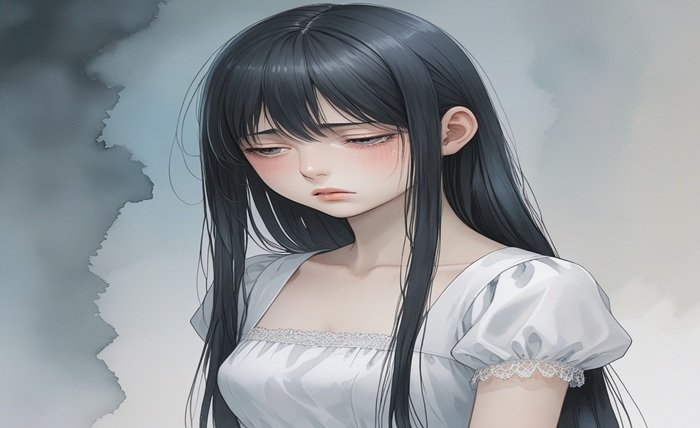Anime has a remarkable ability to engage its audience emotionally. It touches on a variety of emotions, from epic conflicts to fantastical journeys. But melancholy is one of anime’s most profound and widely understandable themes. In particular, the “sad anime girl” cliché has won over fans’ hearts and attention worldwide. This cliché frequently includes female protagonists whose narratives are characterized by loss, heartbreak, or personal pain. Because we recognize ourselves mirrored in their suffering, resiliency, and development, the way these characters are portrayed frequently inspires strong empathy and introspection in the audience.
What Defines a Sad Anime Girl?
Generally speaking, a “sad anime girl” is a female character who goes through a period of intense emotional upheaval, whether it be from trauma, grief, loneliness, or unrequited love. These people frequently encounter tragic circumstances that test their capacity for emotional fortitude. The grief often influences the character’s growth and behavior, which is not merely superficial but permeates the entire plot. These characters go through hardships that highlight both their strength and fragility, whether it’s because of emotional isolation, challenging past experiences, or the death of a loved one.
The Appeal of Sadness in Anime
The grief shown in these stories strikes a deep chord with many viewers, as anime is an art form that frequently emphasizes emotional depth. We are all accustomed to experiencing sadness and hopelessness, and anime provides a safe and regulated environment for us to explore these feelings. Empathy, sympathy, and the catharsis of witnessing a character work through their sadness are the factors that contribute to our relationship with depressed anime ladies.
Furthermore, these depressing people are frequently depicted with complexity and nuance, which makes them realistic and approachable. They demonstrate that there is potential for development, fortitude, and occasionally even healing even amid the most agonizing situations.
Recognizing the Sad Anime Girl Trope’s History
The broader history of manga and anime is where the sad anime girl cliché originated. Since the beginning of Japanese animation, tragic backstories and emotionally nuanced characters have been used. Works from the 1960s and 1970s, when anime frequently depicted characters in unusual, occasionally sad situations, are one of the earliest instances.
The “sad anime girl” did not, however, gain popularity until the 1980s and 1990s, especially in the “shoujo” (sad anime girl) and “slice of life” anime genres. Sadness emerged as a major subject in these genres, which frequently concentrated on the emotional journeys of female protagonists. The idea of the melancholy girl extended throughout anime as it developed, appearing in fantasy, drama, romance, and even horror.
Sad Anime Girls’ Typical Characteristics
The trope is defined by several recurrent characteristics of depressed anime girls. These are a few of the most typical ones:
Trauma or Loss: A depressed anime girl frequently has a heartbreaking past that includes abandonment, the death of a loved one, or some other type of trauma that has influenced her life.
Introversion or Isolation: Because of their prior experiences, a lot of depressed anime ladies have a tendency to be introverted, emotionally withdrawn, or socially isolated. They can have trouble feeling alone.
Vulnerability: Because these characters frequently come across as vulnerable, viewers are drawn to their emotional storylines. One of the most important aspects of their character development is their grief.
Quiet power: Many depressed anime females exhibit incredible inner power despite their grief. They persevere through their struggles and frequently serve as role models for others.
The Stories of the Top 5 Iconic Sad Anime Girl
Although there are many depressed anime girls in the world, these five well-known ones have had a profound impact on viewers:
Puella Magi Madoka Magica by Homura Akemi (2011)
In Puella Magi Madoka Magica, Homura embodies the quintessential tragic figure. She endures never-ending cycles of suffering throughout the series while frantically attempting to spare her buddy Madoka from a terrible conclusion. Her grief is a result of witnessing Madoka’s suffering and the burden of constantly going through the same traumatic experiences. Heartbreak, self-sacrifice, and eventually hope are all parts of her journey.
Negima! by Nodoka Miyazaki (2004)
Nodoka starts as a timid, nervous young woman, but her emotional distance from other people is a result of her pain and thoughts of inadequacy. Her emotional burden of being outshined by others and her need for love and appreciation are the main causes of her melancholy. She becomes one of the most heartbreaking characters in the series as her character develops over time, yet her sadness never goes away.
Fate/Stay Night by Saber (2006)
Because of her history as King Arthur, Saber, one of the main characters in the Fate/Stay Night series, bears a heavy burden of melancholy. Her tragic story centers on her sense of duty and obligation as well as her inability to fulfill her ambitions. She is one of the most recognizable depressed anime ladies in history because, despite her noble façade, her heartbreak is at the heart of her persona.
Future Diary by Yuno Gasai (2011)
Even though Yuno is a complicated character in Future Diary, her tragic past and deep love make her a depressing anime lady. Because of her challenging past and the extent she goes to to keep her love safe, her emotions are overwhelming. Much of the plot’s drama is driven by her sadness and fixation with Yukiteru, revealing the darker side of the depressing anime heroine cliché.
Sad Anime Girl Psychological Effects on Viewers
Viewers, particularly those who have suffered from personal sorrow or loss, might be profoundly impacted by sad anime heroines. Fans can feel recognized, acknowledged, and less alone in their feelings because of the way these characters are portrayed. Viewers can learn about their own emotional lives by going through these characters’ hardships, which frequently results in catharsis or a sense of healing.
In a psychological sense, viewers may find themselves thinking back on their own experiences of loss, grief, or emotional suffering as a result of these folks’ misery. Observing these characters’ coping mechanisms can teach viewers important lessons about self-acceptance, resilience, and the value of personal development.
How the Depressing Sad Anime Girl Character Mirrors Challenges in the Real World
Even though anime characters are made up, the feelings they go through frequently mirror difficulties that many people have in the real world. Anime’s depictions of melancholy can be used to examine common human situations including heartbreak, loneliness, loss, and healing.
The internal conflicts that viewers may experience in their own lives are frequently reflected in these characters. The path of a depressed anime heroine frequently strikes a profound chord with viewers who recognize the challenges mirrored in these characters, whether it’s overcoming bereavement, finding strength after trauma, or just learning to live with pain.
Conclusion: The Sad Anime Girl’s Lasting Legacy
One stereotype that cuts across cultural lines is the depressed sad anime girl. These characters have had a lasting impact on anime history because of their heartbreak, suffering, and depth of emotion. They have been used by anime creators to examine themes of resiliency, loss, and redemption. These characters have grown to be some of the most adored and recognizable in anime, whether it is because of their tragic past or their continuous emotional journey.
Questions and Answers (FAQ)
Who are some of the most well-known anime girls who are depressed?
Among the most well-known depressed anime girls are Nodoka Miyazaki (Negima!), Yuno Gasai (Future Diary), Saber (Fate/Stay Night), and Homura Akemi (Puella Magi Madoka Magica).
Why do so many people identify with depressed anime girls?
Viewers identify with sad anime girls because their hardships reflect feelings like loneliness, loss, and grief that occur in the real world. Those who can relate to their experiences find hope and catharsis in their paths of development and recovery.
Are depressed anime heroines always “redeemed” after their tale?
Not all the time. Some stories leave their fate open-ended or unresolved, which highlights the intricacy of their emotional difficulties even though many depressed anime ladies do attain some sort of healing or redemption.

